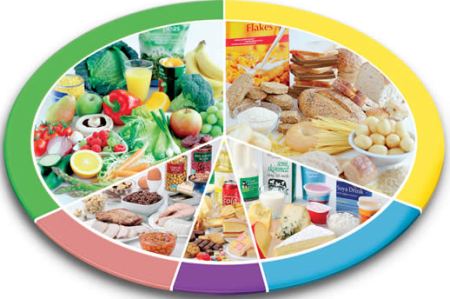Learn your food groups
Our body needs all the food groups. Singling out one to the exclusion of other could send you into a tall spin of deficiencies and cravings. A well balanced diet with the right combination of carbohydrates, proteins, and fats is advised.
Carbohydrates are a group of health foods that range from the cereal/bread group to vegetables and fruits. In India we tend to consume too much of the cereal/bread faction and too little of the fruits and vegetables (which we near kill and then try to resuscitate with out methods of cooking). This was originally for economic reasons – rice/wheat being cheaper than vegetables.
A small cup (or two servings) of rice or two slices of whole wheat bread should suffice for most people. When eaten with adequate amounts of vegetables, protein in the form of lentils or meat protein (as long as it is not drowning in a soup of oil) creates a sense of satiety. A minimum of two fruits and 3-4 servings of vegetables a day on an average is required to provide us with all the minerals, vitamins phytochemicals and antioxidants.
Soups are a great way to curtail hunger while obtaining a wide variety of micro-nutrients. Eat health foods with a lower Glycemic Index – those that are absorbed slowly and keep the blood sugar stable. Most vegetables fibrous fruits and whole grains fall in this category. Processed health foods are another special category that needs to be avoided. Fats are present naturally in health foods, half a liter of oil per adult a month is more than sufficient while cooking. The polyunsaturated oils (sunflower) have been popularized as the solution to high cholesterol.
Consuming only this form of oil can be detrimental to good health. Switch between, groundnut, sesame, sunflower, olive, rice bran, almond, linseed. Vegetarians need to eat some linseed/flaxseed/walnut oil to obtain the benefits of Omega-3 fats present in oily fish. Beware of oily, creamy curries/gravies that carry a lot of hidden calories.
Simple cooking
Keep everyday cooking simple. We could learn from the rural Chinese cooking of vegetable, which are stir fried on high heat for a very short period of time to retain flavor and nutrients. Low fat cheeses are the hard cheeses and cottage cheese. Saturated fats – butter, cream and ghee – need to be kept to the minimum. Hydrogenated fats, made specially by adding hydrogen to polyunsaturated vegetable fat, used primarily in baking, preserving and processed health foods have been clearly indicated as a cause of atherosclerosis.
Protein matters
Protein is present in the animal meats and fish. The vegetarian sources are lentils, soy, mil (preferably skimmed) and milk products. Most animal proteins also contain a fair amount of saturated fat. Although recently high glycemic index carbohydrates seem more responsible for arterial and cardiac disease than saturated fats, keeping red meat to the minimum, healthy eating more oily fish is a more sensible solution.
- Protein is required for muscle building and repair of tissues.
- 0.8 gm of protein/kg body weight for an adult is sufficient.
- 1gm/kg if you are weight training.
- Higher amounts for body builders.
Eat smaller proteins, more frequently, but slowly, chew properly, and drink water to stay hydrated (definitely not the carbonated drinks, even the diet variety). All the advice given to us as children.
Don’t starve for large parts of the day only to eat a heavy meal at the end. Eat a variety of health food to enable the absorption of the various micronutrients that are so important for the proper functioning of our body. Approach food with respect and prudence, but delight and pleasure. Recognize if you use it as a defense mechanism, stress buster or comforter. It is not supposed to be. Eat mindfully.

